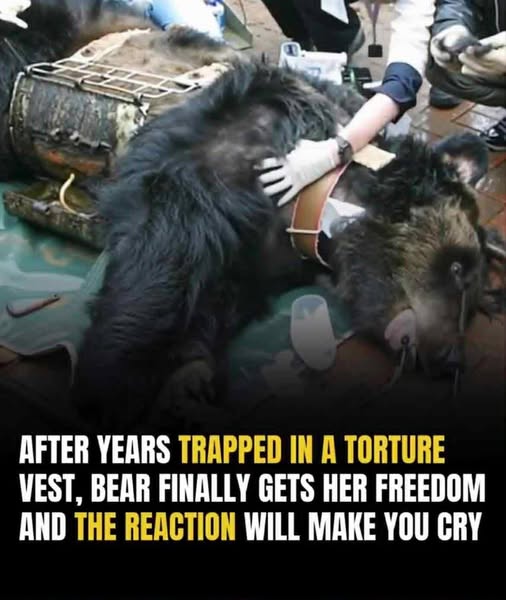Imagine spending your entire life confined to a cage—barely able to move, never feeling sunlight, stripped of freedom and dignity. That was the reality for Caesar, a moon bear who endured years of unimaginable suffering on a bile farm in China.
Her existence was defined by pain. Day after day, she lay trapped in a tiny cage, her body restrained by a crude metal vest designed to keep her immobile while her gallbladder was drained for bile — a substance sold for use in traditional medicine. The device cut into her flesh, infected her wounds, and made every breath a reminder of her captivity.
For years, Caesar knew nothing but agony. Her life was reduced to a commodity — her body used, her suffering ignored.
Then, in 2004, everything changed.
An animal welfare organization, Animals Asia, led a daring rescue that finally freed her from the hellish bile farm. When rescuers arrived, they found her weak, scarred, and terrified of human contact. Her muscles had atrophied from disuse, and deep grooves from the metal vest carved permanent marks into her body.
“It was the worst form of torture imaginable,” the team said. “Her condition was heartbreaking — but her spirit, even then, was unbroken.”
Over time, with patience and care, Caesar began to heal. At the Animals Asia sanctuary in Chengdu, she learned what it meant to live freely — to dig in the soil, to swim under the sun, to nap in the cool autumn air without fear. Her transformation was astonishing.
“Caesar’s scars have almost vanished,” Animals Asia wrote in 2016, twelve years after her rescue. “She is an incredibly beautiful and powerful bear, a living testament to resilience.”
Visitors and caretakers alike were moved by her presence. Watching her splash joyfully in the pond or roll on her back under falling leaves was like witnessing rebirth. She had spent over a decade as a prisoner, yet she carried herself with the grace of a creature rediscovering her place in the world.
Nic Field, director of the China Bear and Vet team, described one unforgettable moment:
“Seeing Caesar shake herself off in the sunshine is pure awe. She’s so strong, so magnificent — it’s almost impossible to imagine the horror she survived. Every time she walks freely, it’s a quiet victory against cruelty.”
For twelve years, Caesar thrived in her sanctuary home. She formed bonds with her caretakers, explored her habitat, and lived as close to wild as her damaged body would allow. The sanctuary staff often said that she reminded them why they fought so hard — because every life saved mattered.
But time and trauma leave scars that even love cannot erase.
Despite her recovery, the years of bile extraction had taken a toll. The constant invasive procedures had caused irreversible internal damage. In her final years, Caesar developed a tumor — a direct result of the repeated gallbladder punctures she’d endured during captivity.
Her caretakers noticed her slowing down. She ate less, moved gently, and spent longer resting under her favorite tree. They did everything they could to keep her comfortable, surrounding her with care and affection.
When she passed away, it was peaceful — surrounded by people who loved her, not by the cold steel bars that had once defined her world.
Her death was a moment of heartbreak for everyone who had fought to give her life back. But it was also a call to action — a reminder of the countless bears still living the nightmare Caesar escaped.
Because while her story ended in freedom, an estimated 10,000 bears remain trapped in bile farms across China. Each one lives as she once did — confined, exploited, suffering silently for the sake of a cruel trade.
Animals Asia has continued its mission to shut down these farms permanently. Their sanctuaries offer rescued bears a second chance — a safe place to rediscover what it means to live. Yet for every Caesar, there are thousands who may never feel grass beneath their paws or see daylight unfiltered through rusted bars.
The use of bear bile is rooted in centuries-old traditional medicine, where it’s believed to have healing properties. But with modern science and synthetic alternatives now available, there is no longer any justification for such barbaric practices. The pain inflicted on these animals serves no medical necessity — only human greed and ignorance.
Caesar’s journey from captivity to freedom has become a symbol of both triumph and tragedy — a reminder of how far compassion can go, and how far we still have to go.
Her rescuers often spoke of her gentleness — how she never lashed out, how her eyes, once full of fear, softened with trust over the years. One caretaker said, “When she looked at you, it was like she understood that not all humans were the same. That maybe, just maybe, she was finally safe.”
And she was.
For more than a decade, Caesar got to live as a bear — to dig, to climb, to sleep under open skies. She was proof that even the most broken souls can heal when given love and dignity.
Her passing left a void at the sanctuary, but her legacy lives on. Her story continues to inspire thousands across the world to support animal rescue efforts and fight against cruelty masked as tradition.
Every time Animals Asia saves another bear, they think of Caesar. Every time a child learns about her story, another seed of empathy is planted.
The sanctuary team released a final tribute after her death:
“Caesar taught us what resilience looks like. She showed us that no matter how much cruelty exists, compassion can win. Her spirit lives on in every bear we rescue.”
Her story is not just about one animal’s suffering — it’s about the moral choice humanity faces every day. Will we continue to exploit, or will we finally learn to protect?
Caesar endured the worst of human cruelty, but she also experienced the best of human kindness. She spent her final years not as a victim, but as a survivor — a teacher of empathy and endurance.
And while her life was far too short, her freedom mattered.
It mattered because it proved that redemption is possible. That one rescue, one act of compassion, can ripple across the world.
Caesar may be gone, but her roar for freedom still echoes — a call for justice for the thousands of bears who wait in silence for someone to care.
Her story reminds us that it’s never too late to fight for mercy, to speak for those who can’t, and to make the world just a little kinder.
Because every bear saved, every cage opened, is another victory against cruelty.
And that’s how Caesar — the bear once trapped in darkness — continues to shine her light.


